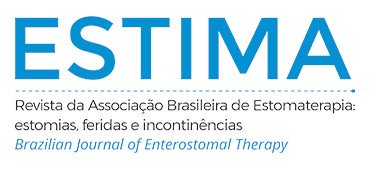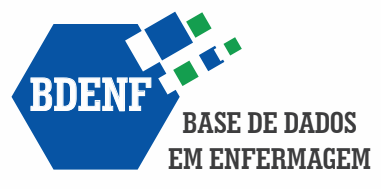CONSTRUCTION AND VALIDITY OF THE ADAPTATION LEVEL SCALE OF THE PERSON WITH OSTOMY
Abstract
Objective: To construct and validate the content of the scale for verifying the level of adaptation of the person with ostomy. Method: Methodological study involving two stages: construction based on two integrative literature reviews and qualitative study with people with stomas; and content validity with judges of the following criteria: behavioral, objectivity, relevance, clarity, simplicity, variety in relation to language; carrying out the pilot test with the target group; lexical and grammatical correction and resubmission to the content validity index. Results: in the first stage, thirteen items received suggestions for improvement, three items were unified by similarity and one was excluded. After the adjustments, a consensus was reached among the judges regarding the representativeness of the items and permanence in the modes based on the evaluated criteria. The target population judged the items as easy to understand, followed by grammatical and lexical correction. Conclusion: The scale presented evidence of content validity demonstrating consensus between the judges and the population.
Downloads
Metrics
References
Sarabi N, Navipour H, Mohammadi E. Relative tranquility in ostomy patients’ social life: A qualitative content analysis. World J Surg 2017;41(8):2136-42. https://doi.org/10.1007/s00268-017-3983-x
2Alencar DC, Andrade EMLR, Rabeh SAN, Araújo TME. Effectiveness of distance education on nurses’ knowledge about bowel elimination ostomies. Rev Gaúcha Enferm 2018;39:e2018-0009. https://doi.org/10.1590/1983-1447.2018.2018-0009
Roy C, Andrews HA. Teoria da enfermagem: O modelo de adaptação de Roy. Lisboa: Instituto Piaget, 2001.
Freire SML, Melo GAA, Lima MMS, Silva RA, Caetano JÁ, Santiago JCS. Contexts of experience of being (un) comfortable in patients with chronic kidney disease. Esc Anna Nery 2020; 24(4):e20190326. https://doi.org/10.1590/2177-9465-EAN-2019-0326
Melo GAA, Silva RA, Aguiar LL, Pereira FGF, Galindo Neto NM, Caetano JÁ. Content validation of the Brazilian version of the General Comfort Questionnaire. Rev Rene 2019;20:e4 1788. https://doi.org/10.15253/2175-6783.20192041788
Pasquali L. Instrumentação psicológica: Fundamentos e práticas. Porto Alegre: Artmed, 2010.
Melo RP, Moreira RP, Fontenele FC, Aguiar ASC, Joventino ES, Carvalho EC. Criterios de selección de expertos para estúdios de validacion de fenómenos de enfermeira. Rev Rene 2011;12(2):424-31.
Alexandre NMC, Coluci MZO. Content validity in the development and adaptation processes of measurement instruments. Ciênc Saúde Coletiva 2011;16(7):3061-8. https://doi.org/10.1590/S1413-81232011000800006
Polit DF, Beck CT. The content validity index: Are you sure you know what’s being reported? Critique and recommendations. Res Nurs Health 2006;29(5):489-97. https://doi.org/10.1002/nur.20147
Scarparo AF, Laus AM, Azevedo ALCS, Freitas MRI, Gabriel CS, Chaves LDP. Reflexões sobre o uso da técnica Delphi em pesquisas na enfermagem. Rev Rene 2012;13(1):242-51.
Sun V, Bojorquez O, Grant M, Wendel CS, Weinstein R, Krouse RS. Cancer survivors’ challenges with ostomy appliances and self-management: A qualitative analysis. Support Care Cancer 2019;28(4):1551-4. https://doi.org/10.1007/s00520-019-05156-7
Stegensek-Mejía EM, Murad-Robles Y, González-Mier MJ, López-Hernández BE, Sánchez-Ojeda E. Derivaciones fecales y urinarias en un centro de atención especializado, México 2016. Enferm Univ 2017;14(4):235-42. https://doi.org/10.1016/j.reu.2017.08.003
Campos K, Bot LHB, Petroianu A, Rebelo PA, Souza AAC, Panhoca I. The impact of colostomy on the patient’s life. J Coloproctol 2017;37(3):205-10. https://doi.org/10.1016/j.jcol.2017.03.004
Moreira WC, Vera SO, Sousa GN, Araújo SNM, Damasceno CKCS, Andrade EMLR. Sexuality of patients with bowel elimination ostomy. R Pesq Cuid Fundam Online 2017;9(2):495-502. https://doi.org/10.9789/2175-5361.2017.v9i2.495-502
Houston N. Reflections on body image and abdominal stomas. Journal of Stomal Therapy Australia 2017;37(3):8-12.
Meira IFA, Silva FR, Sousa AR, Carvalho ESS, Santa Rosa DO, Pereira A. Repercussions of intestinal ostomy on male sexuality: An integrative review. Rev Bras Enferm 2020;73(6):e20190245. https://doi.org/10.1590/0034-7167-2019-0245
Sasaki VDM, Teles AAS, Silva NM, Russo TMS, Pantoni LA, Aguiar JC, Sonobe HM. Self-care of people with intestinal ostomy: Beyond the procedural towards rehabilitation. Rev Bras Enferm 2021;74(1):e20200088. https://doi.org/10.1590/0034-7167-2020-0088
Ianiski VB, Alpe ACOES, Rios KR, Oliveira KR, Stumm EMF. Vivências e desafios de estomizados assistidos na atenção primária à saúde. Revista Saúde Integrada 2019; 12(23):69-80.
Reisdorfer N, Locks MOH, Girondi JBR, Amante LN, Corrêa MS. Processo de transição para vivência com estomias intestinais de eliminação: Repercussões na imagem corporal. ESTIMA, Braz J Enterostomal Ther 2019;16:e1219. https://doi.org/10.30886/estima.v16.683_PT
Cengiz B, Bahar Z. Perceived barriers and home care needs when adapting to a fecal ostomy: A phenomenological study. J Wound Ostomy Continence Nurs 2017;44(1):63-8. https://doi.org/10.1097/WON.0000000000000271
Sasaki VDM, Teles AAS, Lima MS, Barbosa JCC, Lisboa BB, Sonobe HM. Reabilitação de pessoas com estomia intestinal: Revisão integrativa. Rev Enferm UFPE On Line 2017;11(Supl. 4):1745-54. https://doi.org/10.5205/1981-8963-v11i4a15271p1745-1754-2017
Roshini AP, Sunny A, Rozario AP. Quality of life assessment in stoma patients in a tertiary care hospital in South India: A crosssectional study. ISJ 2017;4(6):2037-41. https://doi.org/10.18203/2349-2902.isj20172408
Geng Z, Howell D, Xu H, Yuan C. Quality of life in Chinese persons living with an ostomy. J Wound Ostomy Continence Nurs 2017;44(3):249-56. https://doi.org/10.1097/WON.0000000000000323
Downloads
Published
How to Cite
Issue
Section
License
Copyright (c) 2022 Lays Pinheiro de Medeiros, Suênia Silva de Mesquita Xavier, Luana Souza Freitas, Isabelle Pereira da Silva, Lorena Brito do O, Silvia Kalyma Paiva Lucena, Renan Alves Silva, Isabelle Katherinne Fernandes Costa

This work is licensed under a Creative Commons Attribution 4.0 International License.

























